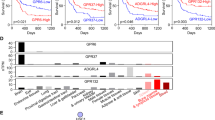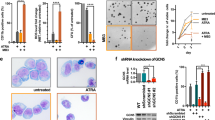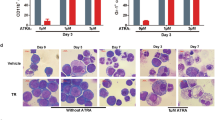Abstract
Acute myeloid leukemia (AML) is the most common form of leukemia in adults. Unfortunately, the standard therapeutic agents used for this disease have high toxicities and poor efficacy. The one exception to these poor outcomes is the use of the retinoid, all-trans retinoic acid (ATRA), for a rare subtype of AML (APL). The use of the differentiation agent, ATRA, in combination with low-dose chemotherapy leads to the long-term survival and presumed cure of 75–85% of patients. Unfortunately ATRA has not been clinically useful for other subtypes of AML. Though many non-APL leukemic cells respond to ATRA, they require significantly higher concentrations of ATRA for effective differentiation. Here we show that the combination of ATRA with glycogen synthase kinase 3 (GSK3) inhibition significantly enhances ATRA-mediated AML differentiation and growth inhibition. These studies have revealed that ATRA’s receptor, the retinoic acid receptor (RAR), is a novel target of GSK3 phosphorylation and that GSK3 can impact the expression and transcriptional activity of the RAR. Overall, our studies suggest the clinical potential of ATRA and GSK3 inhibition for AML and provide a mechanistic framework to explain the promising activity of this combination regimen.
This is a preview of subscription content, access via your institution
Access options
Subscribe to this journal
Receive 12 print issues and online access
$259.00 per year
only $21.58 per issue
Buy this article
- Purchase on Springer Link
- Instant access to full article PDF
Prices may be subject to local taxes which are calculated during checkout







Similar content being viewed by others
References
Estey EH . General approach to, and perspectives on clinical research in, older patients with newly diagnosed acute myeloid leukemia. Semin Hematol 2006; 43: 89–95.
Tallmann MS . Curative therapeutic approaches to APL. Ann Hematol 2004; 83 (Suppl 1): S81–S82.
Wald DN, Vermaat HM, Zang S, Lavik A, Kang Z, Peleg G et al. Identification of 6-benzylthioinosine as a myeloid leukemia differentiation-inducing compound. Cancer Res 2008; 68: 4369–4376.
Gupta K, Chakrabarti A, Rana S, Ramdeo R, Roth B, Agarwal M et al. Securinine, a myeloid differentiation agent with therapeutic potential for AML. PLoS One 2011; 6: e21203.
Wang Z, Smith KS, Murphy M, Piloto O, Somervaille TC, Cleary ML . Glycogen synthase kinase 3 in MLL leukaemia maintenance and targeted therapy. Nature 2008; 455: 1205–1209.
Holmes T, O’Brien TA, Knight R, Lindeman R, Shen S, Song E et al. Glycogen synthase kinase-3beta inhibition preserves hematopoietic stem cell activity and inhibits leukemic cell growth. Stem Cells 2008; 26: 1288–1297.
Song EY, Palladinetti P, Klamer G, Ko KH, Lindeman R, O’Brien TA et al. Glycogen synthase kinase--3beta inhibitors suppress leukemia cell growth. Exp Hematol 2010; 38: 908–921 e901.
Rayasam GV, Tulasi VK, Sodhi R, Davis JA, Ray A . Glycogen synthase kinase 3: more than a namesake. Br J Pharmacol 2009; 156: 885–898.
Doble BW, Woodgett JR . GSK-3: tricks of the trade for a multi-tasking kinase. J Cell Sci 2003; 116 (Part 7): 1175–1186.
Grimes CA, Jope RS . The multifaceted roles of glycogen synthase kinase 3beta in cellular signaling. Prog Neurobiol 2001; 65: 391–426.
Hernandez F, Nido JD, Avila J, Villanueva N . GSK3 inhibitors and disease. Mini Rev Med Chem 2009; 9: 1024–1029.
Medina M, Castro A . Glycogen synthase kinase-3 (GSK-3) inhibitors reach the clinic. Curr Opin Drug Discov Devel 2008; 11: 533–543.
Guzman ML, Li X, Corbett CA, Rossi RM, Bushnell T, Liesveld JL et al. Rapid and selective death of leukemia stem and progenitor cells induced by the compound 4-benzyl, 2-methyl, 1,2,4-thiadiazolidine, 3,5 dione (TDZD-8). Blood 2007; 110: 4436–4444.
Zhou Y, Uddin S, Zimmerman T, Kang JA, Ulaszek J, Wickrema A . Growth control of multiple myeloma cells through inhibition of glycogen synthase kinase-3. Leuk Lymphoma 2008; 49: 1945–1953.
Martinez A . Preclinical efficacy on GSK-3 inhibitors: towards a future generation of powerful drugs. Med Res Rev 2008; 28: 773–796.
Collins SJ, Ruscetti FW, Gallagher RE, Gallo RC . Normal functional characteristics of cultured human promyelocytic leukemia cells (HL-60) after induction of differentiation by dimethylsulfoxide. J Exp Med 1979; 149: 969–974.
Newburger PE, Chovaniec ME, Greenberger JS, Cohen HJ . Functional changes in human leukemic cell line HL-60. A model for myeloid differentiation. J Cell Biol 1979; 82: 315–322.
Collins SJ, Bodner A, Ting R, Gallo RC . Induction of morphological and functional differentiation of human promyelocytic leukemia cells (HL-60) by componuds which induce differentiation of murine leukemia cells. Int J Cancer 1980; 25: 213–218.
Guglielmo P, Pagano MC, Giustolisi R . [The nitroblue tetrazolium activated test in the study of granulocytic function. Proposed methodology]. Boll Soc Ital Biol Sper 1980; 56: 183–187.
Newburger PE, Speier C, Borregaard N, Walsh CE, Whitin JC, Simons ER . Development of the superoxide-generating system during differentiation of the HL-60 human promyelocytic leukemia cell line. J Biol Chem 1984; 259: 3771–3776.
Prakash R . A review of the hematologic side effects of lithium. Hosp Community Psychiatry 1985; 36: 127–128.
Dixon JF, Hokin LE . Lithium acutely inhibits and chronically up-regulates and stabilizes glutamate uptake by presynaptic nerve endings in mouse cerebral cortex. Proc Natl Acad Sci USA 1998; 95: 8363–8368.
Grandjean EM, Aubry JM . Lithium: updated human knowledge using an evidence-based approach. Part II: clinical pharmacology and therapeutic monitoring. CNS Drugs 2009; 23: 331–349.
MacAulay K, Blair AS, Hajduch E, Terashima T, Baba O, Sutherland C et al. Constitutive activation of GSK3 down-regulates glycogen synthase abundance and glycogen deposition in rat skeletal muscle cells. J Biol Chem 2005; 280: 9509–9518.
Li X, Friedman AB, Zhu W, Wang L, Boswell S, May RS et al. Lithium regulates glycogen synthase kinase-3beta in human peripheral blood mononuclear cells: implication in the treatment of bipolar disorder. Biol Psychiatry 2007; 61: 216–222.
Si J, Mueller L, Collins SJ . GSK3 inhibitors enhance retinoic acid receptor activity and induce the differentiation of retinoic acid-sensitive myeloid leukemia cells. Leukemia 2011; 25: 1914–1918.
Farboud B, Privalsky ML . Retinoic acid receptor-alpha is stabilized in a repressive state by its C-terminal, isotype-specific F domain. Mol Endocrinol 2004; 18: 2839–2853.
Bushue N, Wan YJ . Retinoid pathway and cancer therapeutics. Adv Drug Deliv Rev 2010; 62: 1285–1298.
Soprano DR, Qin P, Soprano KJ . Retinoic acid receptors and cancers. Annu Rev Nutr 2004; 24: 201–221.
Author information
Authors and Affiliations
Corresponding author
Ethics declarations
Competing interests
The authors declare no conflict of interest.
Rights and permissions
About this article
Cite this article
Gupta, K., Gulen, F., Sun, L. et al. GSK3 is a regulator of RAR-mediated differentiation. Leukemia 26, 1277–1285 (2012). https://doi.org/10.1038/leu.2012.2
Received:
Revised:
Accepted:
Published:
Issue Date:
DOI: https://doi.org/10.1038/leu.2012.2
Keywords
This article is cited by
-
GSK-3: a multifaceted player in acute leukemias
Leukemia (2021)
-
Salt-inducible kinase inhibition sensitizes human acute myeloid leukemia cells to all-trans retinoic acid-induced differentiation
International Journal of Hematology (2021)
-
Creatine kinase pathway inhibition alters GSK3 and WNT signaling in EVI1-positive AML
Leukemia (2019)
-
Retinoic Acid Receptor α Knockdown Suppresses the Tumorigenicity of Esophageal Carcinoma via Wnt/β-catenin Pathway
Digestive Diseases and Sciences (2018)
-
Repression of GSK3 restores NK cell cytotoxicity in AML patients
Nature Communications (2016)



